 |
|
 |
|
Tracking
Quizzes
|
Quiz #49 - Answer
by Brian Booth |
|
|
 |
Photo 49G
The mystery
animal is MOUNTAIN GOAT. I got to watch these tracks being made, and
the adult ewe in the photo is the animal who made these tracks.
|
|
The mountain goat is a hoofed animal, with feet similar to deer and
elk.
The clues that help suggest these tracks were from a
mountain goat include:
The relatively small size of the tracks would
rule out these tracks as being from elk. Elk in this region are known as
“Roosevelt elk”, a population of elk that grow to enormous size. (The
name comes from Teddy Roosevelt, who was instrumental in establishing
the area as a national park, mainly because of the trophy-specimen elk
that live here.)
The toes in the tracks are more blunt than a deer.
(Actually, it’s not as simple as it sounds. Mountain goat tracks vary a
lot from one footprint to another, with many footprints looking exactly
like a deer. You have to examine a lot of footprints to confirm a trail
is from a mountain goat and not a deer. I did you a favor and only
included the most highly “goat-looking” tracks in the trail in this
quiz.)
The toes are splayed apart, nearly parallel to each other,
forming what some people describe as “boxy” shaped tracks. (Deer toes
point inwards towards the center of the track, forming a more
heart-shaped footprint.) (Again, mountain goat footprints vary a lot,
and I only included the most highly “goat-looking” tracks in the trail
in this quiz.)
The high alpine location of the tracks, which is more
closely associated with mountain goat than deer or elk, is NOT really a
clue that supports identifying these tracks as mountain goat. Deer and
elk also inhabit high alpine meadows like this, and in fact there were
both deer and elk tracks in close proximity to these mountain goat
tracks.
This tracking experience – seeing deer & elk tracks
in what would ordinarily be considered “mountain goat terrain” –
solidified a lesson I learned from the outstanding tracker John
McCarter, who has pointed out to me a number of times that habitat is
one of the least reliable clues in identifying tracks. As an example on
a Massachusetts winter field trip, he pointed out examples of mink and
otter tracks that were over a half mile from the nearest water. |
 |
Photo 49H
However, in
this case, these tracks were indeed from a mountain goat, the regal
king of the lofty peaks. These animals are truly inspirational to
see in the wilderness. They have massive muscles, can endure
extremely harsh and cold conditions, and can scale nearly-vertical
cliffs. I saw 24 mountain goats on this trip, and will relish it as
one of my greatest life adventures.
Wishing you all
great tracking adventures in the near future as well.
Until next
quiz,
BRIAN |
|
Quiz #49 - Question
...on to Quiz #50 |
| |
|
(All photos on this page are Copyright © by Brian Booth
or Walter Muma unless indicated otherwise)
To send comments, questions or feedback about these quizzes,
email me |
| |
|
Tracking Quizzes |
| |
|
|